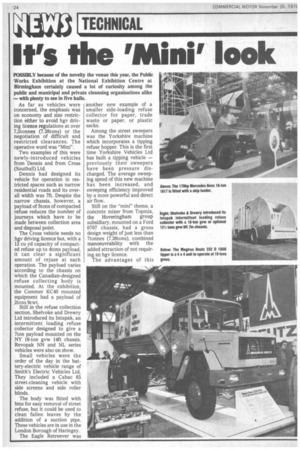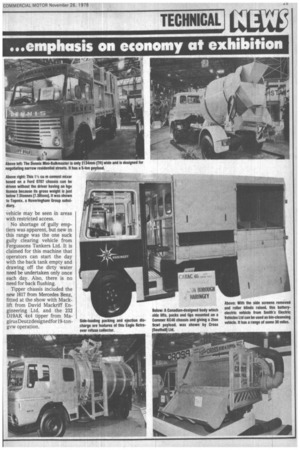It's the 'Mini look
Page 26

Page 27

If you've noticed an error in this article please click here to report it so we can fix it.
POSSIBLY because of the novelty the venue this year, the Public Works Exhibition at the National Exhibition Centre at Birmingham certainly caused a lot of curiosity among the public and municipal and private cleansing organisations alike — with plenty to see in five halls.
As far as vehicles were concerned, the emphasis was on economy and size restriction either to avoid hgv driving licence regulations at over 7.5tonnes (7.38tons) or the negotiation of difficult and restricted clearances. The operative word was "Mini".
Two examples of this were newly-introduced vehicles from Dennis and from Cross (Southall) Ltd.
Dennis had designed its vehicle for operation in restricted spaces such as narrow residential roads and its overall width was 7ft. Despite the narrow chassis, however, a payload of 5tons of compacted refuse reduces the number of journeys which have to be made between collection area and disposal point.
The Cross vehicle needs no hgv driving licence but, with a 12 cu yd capacity of compacted refuse up to 4tons payload, it can clear a significant amount of rejuse at each operation. The payload varies according to the chassis on which the Canadian-designed refuse collecting body is mounted. At the exhibition, the Commer KC40 mounted equipment had a payload of .2tons 9cwt. Still in the refuse collection section, Shelvoke and Drewry Ltd introduced its Intapak, an intermittent loading refuse collector designed to give a 7ton payload mounted on the NY 16-ton gvw 14ft chassis. Revopak NN and NL series vehicles were also on show.
Small vehicles were the order of the day in the battery-electric vehicle range of Smith's Electric Vehicles Ltd. They included a Cabac 65 street-cleaning vehicle with side screens and side roller blinds.
The body was fitted with bins for easy removal of street refuse, but it could be used to clean fallen leaves by the addition of a suction pipe. These vehicles are in use in the London Borough of Haringey.
The Eagle Retreever was another new example of a smaller side-loading refuse collector for paper, trade waste or paper, or plastic sacks.
Among the street sweepers was the Yorkshire machine which incorporates a tipping refuse hopper. This is the first time Yorkshire Vehicles Ltd has built a tipping vehicle — previously their sweepers have been pressure discharged. The average sweeping speed of this new machine has been increased, and sweeping efficiency improved by a more powerful and direct air flow.
Still on the "mini" theme, a concrete mixer from Topmix, the Hoveringham group subsidiary, mounted on a Ford 0707 chassis, had a gross design weight of just less than 7tonnes (7.38tons), combined manoeuvrability with the added attraction of not requiring an hgv licence.
The advantages of this vehicle may be seen in areas with restricted access.
No shortage of gully emptiers was apparent, but new in this range was the one suck gully clearing vehicle from Fergussons Tankers Ltd. It is claimed for this machine that operators can start the day with the back tank empty and drawing off the dirty water need be undertaken only once each day. Also, there is no need for back flushing.
Tipper chassis included the new 1617 from Mercedes Benz, fitted at the show with Macklift from David Mackriff Engineering Ltd. and the 232 D19AK 4x4 tipper from Magirus Deutzdesignedfor 19tongvw operation.








































































































